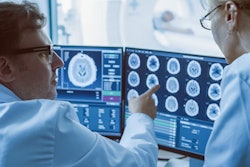
Pressures on the healthcare system, such as staffing challenges and growing patient care demand, are prompting a reimagining of job duties and roles in imaging -- including interest in developing multimodality technologist positions, according to an August 11 presentation at the AHRA 2020 annual meeting.
The COVID-19 pandemic is adding impetus for this change, said presenter Leslie Jebson of Texas A&M Health Science Center in Bryan, TX.
"We're in the midst of COVID-19, and we have to adapt," he said. "It's particularly appropriate that this adaptation would include new staffing models."
Technologists who offer dual-modality skills -- such as cath lab and interventional radiology -- are already present in the healthcare system. But there may be a need for staff who can manage three modalities or more.
"Healthcare as a whole, and radiology as well, is largely structured by specialization, focusing on a linear path toward ultrasound, digital imaging, CT, or nuclear medicine," he said. "But the trend toward multimodality technologist positions for three-plus modalities is happening."
Jebson defined the multimodality technologist as someone who, for example, could perform mammography, diagnostic radiology, and bone mineral density exams under the supervision of a radiology manager or supervisor, using a variety of equipment across a variety of locations and clinical services. (For the purposes of his talk, he did not include nuclear medicine technologists in the mix, noting that their training and service is very specific.)
Jebson noted that the American Registry for Radiologic Technologists (ARRT) offers 15 credentials for a variety of imaging applications and modalities.
"Multimodality technologists could also coordinate and participate in training other techs, fellows, residents, physicians, and other visiting health professionals," he said.
Jebson suggested radiology department administrators consider the following questions regarding adding multimodality technologists to the staff roster:
- Is there a fundamental workforce need or knowledge scarcity that multimodality technologists could mitigate?
- Does your delivery setting warrant this kind of position? Are imaging services scattered or centralized?
- Does your facility have the scheduling and financial management structure to support this type of position?
Jebson also listed a series of minimum educational considerations for multimodality technologist staff:
- Graduate of ARRT-approved radiology technologist program
- ARRT registry eligible and registered within one year of hire
- Three to five years radiology technologist experience
- ARRT licensure imaging skills as defined by their modality
- Minimum of five years MRI imaging experience and current MRI certification
Finally, he offered advice about how to start exploring adding multimodality technologists to a department or practice.
"Don't try and roll this out broadly right away," he said. "If you're intrigued by a multimodality model, try a pilot program that supports a particular area -- like neuroscience, orthopedics, cardiovascular, or oncology -- developing a few staff members between two or three units in the radiology department."




















